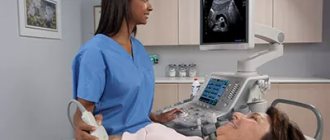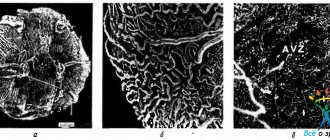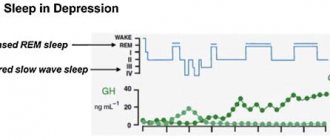Symptoms of autonomic dysfunction of the heart
The symptoms of autonomic dysfunction are quite easy to identify, but to make a final diagnosis, the doctor needs to accurately answer the following questions: are these symptoms a sign of an independent disease or a manifestation of another, somatic, neurological, or mental disease? Could they mean the presence of cardiovascular system (cardiovascular system) pathology: hypertension, coronary artery disease, valve defects, myocardial inflammation?
When establishing a diagnosis of autonomic dysfunction, the following are taken into account:
- multiplicity and variety of complaints, mainly related to the cardiovascular system;
- prolonged course with episodes of exacerbations and attenuation of symptoms;
- does not lead to complications (heart failure);
- discrepancy between complaints and objective data, examination results.
Identifies the main and additional diagnostic signs of autonomic dysfunction
. A diagnosis can be considered reliable if there are two or more main and 2 additional signs.
Main features:
- pain in the precordial area of various types (pressing, stabbing, burning, cutting, drilling, aching);
- respiratory disorders - shortness of breath, feeling of lack of air, dissatisfaction with breathing, not associated with physical activity;
- instability of blood pressure and pulse, their inadequate change in response to physical activity, attacks of rapid heartbeat;
- nonspecific modifications of the ST segment, T wave on the electrocardiogram, early ventricular repolarization syndrome;
- restoration of a negative T wave on the electrocardiogram after physical activity, positive orthostatic and hyperventilation tests with beta-blockers.
Additional signs:
- tachycardia or bradycardia, interruptions in heart function;
- lability of body temperature, low-grade fever, hot flashes, chills, muscle pain, paresthesia;
- dizziness, presyncope and syncope (fainting);
- emotional instability, feelings of anxiety, fear, increased irritability, tearfulness;
- general weakness, fatigue, decreased performance; absence of signs of organic pathology from the cardiovascular system, nervous system, mental disorders.
There are also signs, the presence of which with one hundred percent probability excludes the diagnosis of autonomic dysfunction. They are revealed during examination and additional examination. These are swelling of the legs, moist rales in the lungs, auscultatory noises in diastole, enlargement of the heart (hypertrophy, dilatation), changes on the ECG (left bundle branch block, AV block II-III degree, focal changes, ST segment displacement, rhythm disturbances except for a single extrasystole), changes in blood tests.
How does this manifest itself?
Indeed, VSD often occurs with periodic increases in temperature, which either decrease on their own or require specialist intervention. The causes of hyperthermia are explained in different ways.
Often the body temperature rises to low-grade levels after vigorous physical activity. Sometimes, with increased activity of the corpus luteum, the temperature may rise in the first three months of pregnancy. A significant increase in temperature can be observed during a hysterical attack, after the cessation of which the body temperature returns to normal on its own. Good conditions for an increase in temperature are endocrine and immunological disorders, as well as what does not sound very common - a conditioned reflex connection, or more simply: a conditioned reflex, when the very measurement of temperature causes a response.
Causes of VSD
The basis of the disease is a violation of the neurohumoral regulation of the autonomic nervous system, which is responsible for the stability and coherence of the activities of all internal organs and the body as a whole. This is a department of the nervous system that is not subject to the consciousness and control of the human will.
There are many causes of the disease. Among the first are hormonal disorders, including transient ones - during puberty, menopause, and pregnancy. Infectious diseases (including physical detraining after infection), foci of chronic infection (caries, sinusitis, tonsillitis), and allergies play a significant role. Psycho-emotional stress, traumatic brain injuries, a sedentary lifestyle, bad habits - smoking, alcohol, unhealthy diet - predispose to the disorder. Hereditary predisposition is important.
Causes of thermoregulation disorders in VSD
When talking about an increase in body temperature during VSD, we must not forget about the lifestyle that an VSD person leads. Namely, he remains in complete isolation from all factors of Nature, thereby detraining his immune system.
In its large mass, the VSD-schnik tries to avoid all physical and psychological activity, which also negatively affects the functioning of the immune system. That is, hemodynamics plays a very important role in thermoregulation.
The presence of foci of odontogenic infection is also of great importance when the temperature rises. After all, body temperature often rises after some provoking factor (stress, exposure to low or high temperature, physical exertion).
Here we can also see a manifestation of a conditioned reflex connection: the provoking factor is associated in the patient with an increase in temperature and, experiencing it, the temperature rises, thereby activating the thermoregulation center of the hypothalamus.
There are two phases of thermoregulation: the physical phase, which provides mechanisms for heat transfer and heat radiation, as well as pathways for the evaporation of water from the surface of the body, and the chemical phase, which occurs with the participation of general and local metabolism, which contributes to increased heat generation.
Diagnosis of thermoregulation disorders is very difficult, since first of all it is necessary to exclude infectious and immunological diseases, tumor-like and systemic connective tissue diseases, etc. But already knowing a particular patient well and the presence of VSD, which also occurs with hyperthermic syndrome, only then can we preliminarily determine the diagnosis.
Diagnosis and treatment of autonomic cardiac dysfunction
Autonomic dysfunction is a diagnosis of exclusion. After a number of cardiovascular diseases have been excluded thanks to laboratory and instrumental methods (ECG, EchoCG, Holter-ECG, etc.), differential diagnostics should be carried out with neuropsychiatric diseases and only in the last place should one think about vegetatives.
Treatment of a disorder of the autonomic nervous system itself should begin with improving lifestyle: regular physical activity, sports (swimming is a priority), elimination of bad habits, a good night's sleep, optimal nutrition, normalization of body weight, hardening.
Medicines used include adaptogens, daytime tranquilizers, nootropics, vascular drugs, antioxidants, and vitamins.
Reduced body temperature
Iron deficiency
11082 09 February
IMPORTANT!
The information in this section cannot be used for self-diagnosis and self-treatment.
In case of pain or other exacerbation of the disease, diagnostic tests should be prescribed only by the attending physician. To make a diagnosis and properly prescribe treatment, you should contact your doctor. Low body temperature: causes of occurrence, what diseases it occurs with, diagnosis and treatment methods.
Definition
Low body temperature, or hypothermia, is a disorder of heat metabolism, manifested by a decrease in body temperature due to exposure to low temperatures and/or a decrease in heat production and an increase in heat output.
There are several mechanisms for active heat production.
Mandatory heat production
- heat produced as a result of normal physiological and metabolic processes. It is enough to maintain normal body temperature in a comfortable ambient temperature.
Additional heat production
activates when the ambient temperature drops and includes:
- non-contractile thermogenesis
, which is carried out by the breakdown of brown fat. Brown fat is present in large quantities in newborns and protects them from hypothermia. In adults there is little of it, it is localized in the neck, between the shoulder blades, near the kidneys; - contractile thermogenesis
, which is based on muscle contraction.
When the body becomes hypothermic, muscle tone (tension) increases and involuntary muscle tremors appear.
Passive heat retention is carried out using subcutaneous fatty tissue.
The rate of metabolic processes and adaptation reactions is influenced by hormones of the adrenal glands and thyroid gland, and the center of thermoregulation is located in the hypothalamus.
For a person, the comfort zone is considered to be the air temperature range from +18°C to +22°C, subject to light clothing and normal physical activity.
There is a distinction between central body temperature (maintained in the internal organs and central vessels at 36.1–38.2°C) and the temperature of peripheral tissues (extremities, body surface) - normally it is tenths of a degree lower than the central temperature.
Central body temperature is measured in the rectum, external auditory canal, and mouth. In a medical facility, it is possible to measure temperature in the lumen of the esophagus, in the nasopharynx, and in the bladder. Peripheral temperature can be measured on the forehead or armpits.
In general, body temperature indicators are individual and each location has its own normal range. Body temperature changes throughout the day. Due to the intensity of metabolic processes, young children have a higher normal temperature level. The metabolism of older people is slow; the internal temperature can normally be at 34–35°C.
Varieties of low temperature
A decrease in temperature can be endogenous (with pathology of internal organs and imperfect thermogenesis) and exogenous (depending on environmental conditions).
An exogenous decrease in temperature includes drug-induced hypothermia. Its task is to reduce the functional activity and metabolism in organs and tissues in order to increase their resistance to oxygen deficiency. It is used in the form of general controlled hypothermia when there is a need to temporarily slow blood circulation; and local controlled hypothermia of individual organs and tissues.
Drug hypothermia is used during open operations on the heart and large vessels, for ischemic stroke, injuries of the central nervous system (brain and spinal cord), and for severe oxygen starvation of newborns.
The severity of a person’s condition is assessed by the level of decrease in core temperature and clinical manifestations.
At a low temperature (36.5–35°C) a person can feel quite well. It follows from this that she is a variant of the norm for him. If a person feels unwell, it is necessary to look for the cause of the drop in temperature.
Body temperature below 35°C is considered low.
Low temperature is detected:
- mild severity (35.0–32.2°C)
, in which drowsiness, increased breathing, heart rate, and chills are observed; - moderate severity (32.1–27°C)
– a person may become delirious, breathing slows down, the heartbeat slows down, reflexes decrease (reaction to an external stimulus); - severe severity (below 27°C)
- a person is in an extreme degree of depression of consciousness (in a coma), blood pressure is reduced, reflexes are absent, deep disturbances in breathing and heart rhythm are noted, the balance of the internal environment of the body and all metabolic processes are disturbed.
Possible causes of low temperature
Possible causes of hypothermia include:
- damage to the central nervous system;
- decreased muscle mass;
- physical fatigue;
- decrease in the speed of metabolic processes;
- pregnancy;
- period of convalescence after a protracted illness;
- dysregulation of vascular tone;
- various intoxications, including alcohol;
- exposure to medications, including overdose of antipyretics;
- intravenous infusion of large volumes of unheated solutions;
- hypothermia in conditions of low air temperature;
- prolonged exposure to wet or damp clothing;
- prolonged exposure to cold water, on cold objects, etc.
All of the above factors can lead to disruption of thermoregulation, decreased heat production, and increased heat loss.
What diseases cause low temperature?
Body temperature can decrease with paresis and paralysis of muscles and/or a decrease in their mass that occurs due to diseases (syringomyelia) and spinal cord injuries, damage to the nerve fibers innervating the muscles, calcium deficiency, hereditary diseases (Erb-Roth muscular dystrophy, Duchenne).
A slowdown in metabolism occurs with chronic insufficient function of the adrenal glands (for example, in autoimmune processes) and the thyroid gland (hypothyroidism), diffuse diseases of the liver, kidneys, with a significant decrease in glucose levels (hypoglycemia), with reduced hemoglobin and/or a decrease in the number of red blood cells (anemia) , with insufficient nutrition, severe exhaustion (cachexia) and thinning of subcutaneous fat.
Violation of thermoregulation is observed with traumatic, medicinal or toxic effects on the hypothalamus.
Hypothermia can occur with extensive multiple trauma or during a systemic infectious process (sepsis).
Which doctors should I contact if I have a low body temperature?
To save a person with severe hypothermia, an emergency medical team must be called.
If a person has recorded a decrease in body temperature by 1–2°C in relation to his individual norm, this condition persists for a long time and is not associated with hypothermia, he should consult a therapist, and, if necessary, a neurologist or endocrinologist.
Diagnostics and examinations for low body temperature
Diagnosis of low body temperature consists of examining and interviewing the patient, measuring body temperature and blood pressure, and assessing blood oxygen saturation (pulse oximetry, blood gas testing).
To identify disturbances in the functioning of organs and systems, the following laboratory and instrumental studies may be prescribed:
- clinical blood test;











